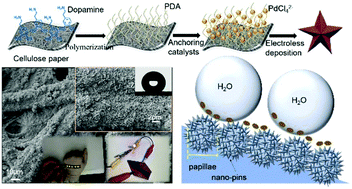A highly conductive, pliable and foldable Cu/cellulose paper electrode enabled by controlled deposition of copper nanoparticles†
Abstract
There is great interest in extending cellulosic platforms to applications in flexible, lightweight, low-cost and sustainable electronics. The critical need is the development of methods to confer electronic properties to these materials platforms (i.e., paper and fabrics). Here we report a highly conductive, pliable and foldable Cu/cellulose paper electrode enabled by a simple low-cost and scalable wet-processing method to coat a Cu nanoparticle (NP) layer on common cellulose paper, where polydopamine adhesion and electroless deposition were used to yield highly conductive paper with a sheet resistance as low as 0.01 Ω sq−1. This Cu/cellulose paper has excellent stability because of the strong adhesion between Cu NPs and cellulose, and because the methods are sufficiently mild to prevent damage to the paper substrate. This fabrication method results in the controlled deposition of Cu NPs and yields Cu/cellulose paper with highly hydrophobic and self-cleaning properties, high photothermal conversion efficiency, and excellent electromagnetic interface (EMI) shielding effectiveness. This high-performance Cu/cellulose paper could have promising application potential for a range of emerging applications in flexible electronics and packaging.



 Please wait while we load your content...
Please wait while we load your content...
